I tested some of the most popular ways of meeting new people. Here's what I found
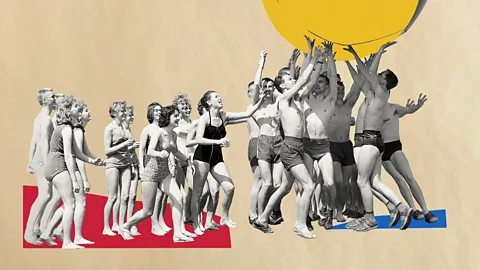 Javier Hirschfeld
Javier HirschfeldWhich hobbies are best for meeting new people? Molly Gorman tested four of them – and discovered surprising facts about how and why we bond as a species.
Walking into a busy climbing gym in London on a Friday night, I feel an overwhelming sense of dread. Desperately gazing past the staff at the reception desk, my eyes lock onto the sea of chalk-covered hands and limbs swinging between multi-coloured holds – all around five metres (16ft) above crash mats.
I am here as part of an experiment for our ongoing BBC series exploring the science – and art – of friendship. Cultivating friendships is key to our wellbeing, and to living a long life. As we mature and become more agreeable, it can actually get easier to form and maintain friendships. But where do you start?
London is a city of nearly nine million people, but like anywhere, it can still be lonely. And without opportunities to mingle, it can be hard to try out and develop different friendship skills and strategies.
Finding a hobby may seem an obvious way to foster social connection – in fact, research suggests that bonding through hobbies is a uniquely human trait. However, given the huge range of potential clubs, classes and activities, which one is actually best for making friends? And is there scientific evidence that some activities have more social potential than others?
To find out, I tested three new activities, and one existing hobby for comparison, and also explored the evidence-backed benefits they might offer. I chose a range of activities, from sports to art, across different budgets. For full transparency, I decided to mention the cost of each activity – since choosing a hobby can also be a matter of affordability. Here's what I found:
1. Team sports: £7 ($9) per week
In late 2020, I moved to London from the countryside. Seeking to make friends in my local area as well as shape some kind of exercise routine, I decided to join a recreational netball league, which is perfect for those who may be more interested in the social aspect of a team sport, as opposed to the competitiveness.
I soon found a wonderful team and we have now played together for four years. Every Monday evening, rain or shine, we take to the court, but we also meet up outside of the sport – whether that's for a drink after a match or dinner on the weekend.
If you are not naturally into ball games, this activity may not feel worth trying out – but research suggests that team sports can have huge benefits for people of all ages and all abilities. Inclusive sports can for example improve the wellbeing of children with disabilities by providing them with the opportunity to "form friendships, express creativity, develop a self-identity and foster a meaning and purpose in life".
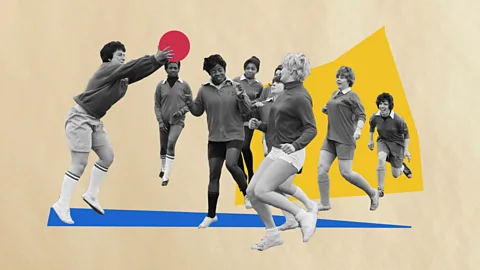 Javier Hirschfeld
Javier HirschfeldAccording to Arran Davis, an expert on social connection and health at the University of Oxford, in the UK, collaborative activities like team sports can not only make exercise feel easier, but can help us build social relationships.
"There's a couple of ways that could happen: the first is just doing stuff together. So what psychologists call 'sharing intention'," he says. This term refers to the phenomenon of connecting over or talking about a common goal or action. As Davis puts it, it's the sense of: "'I think about what you're thinking about, you think about what I'm thinking about'."
Shared intention "makes us feel a bit closer to one another and that can lead us to view one another as good cooperative partners or people that we feel more similar to", he says. "And these are the things that build friendships… through coordinating or collaborating, we're able to signal to each other that we're friends," he explains.
Davis goes on to explain how endorphins and other natural chemicals released in the body when we do aerobic exercise, for example the feeling of "runner's high", can be enhanced when we're working in a team. "Interestingly, these chemicals are also involved in primate bonding. When primates groom each other, they release endorphins, or when we laugh together, we release endorphins," he says. "So this gives us a positive feeling that we then start to associate with the people around us. It can be a way to build connection through sharing a positive psychological state."
A 2023 study compared social bonding between humans, and between other primates. It concluded that there may be something unique about the way we as humans bond through shared experiences, whether it's taking a walk together, dancing together, making music together, playing team sports or even just having a conversation. While positive social bonds are generally important for all primates, our special ability as humans to connect through shared, interactive experiences may help us learn more about each other, and ultimately coordinate and maintain larger social networks than other primates, according to the study.
For adults, team sport participation typically declines in older age, but research suggests it's never too late. One study examined the reasons why a group of adults over the age of 55 engage in team sports and found that community and togetherness were an important motivation, as well as the potential health benefits.
From my experience, team sports are fantastic for making friends because not only do you see the same people on a weekly basis, but playing a sport together provides a topic of conversation to discuss and bond over. I have made lifelong friends through netball, and it always brings a burst of joy to my week (even when we lose).
Still, I was curious about whether adding other activities could help me widen my social circle further – and reveal insights into our relationship with ourselves, as well as with others. That's how I ended up in the chalk-dusted bouldering gym...
2. Bouldering: £34 ($40) for a beginners' session
Bouldering is a type of climbing where the route is "short but tricky" and is performed without a harness or ropes. Studies on bouldering and mental health suggest that the sport may have a positive effect on symptoms of depression, more so than home-based exercise, for example. In one study, 133 patients with depression were assigned bouldering psychotherapy for ten weeks – the results showed that bouldering alleviated their symptoms. (Of course, depression is a complex condition, and if you are worried about your mental health, you should consult your healthcare provider for advice and support.)
As with team sports, the benefits of climbing and bouldering extend across different ages and abilities. Researchers surveying US Veterans and non-Veterans with disabilities found a range of potential therapeutic benefits to adaptive rock and rope climbing, for example, including community connection, confidence-building, and muscle strengthening.
I certainly found that bouldering had a positive effect on my mind. When I was climbing, my sole focus was concentrated on my next move: where my feet needed to go, how to swing my hips to reach the next hold and ensuring I kept a steady grip. Essentially, it felt like problem-solving combined with a physical challenge.
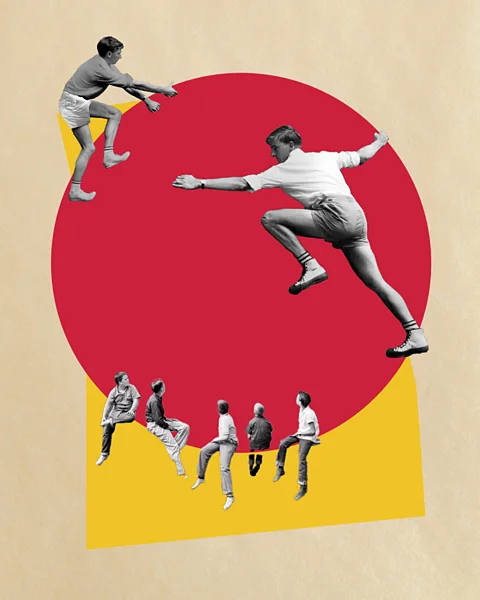 Javier Hirschfeld
Javier HirschfeldWhen I was taking a rest and observing groups of climbers in the middle of the mats, both chatting and looking out for fellow climbers on the wall, it also became clear that bouldering is a very social sport – they were offering support, encouragement and guidance to each other. Climbing gyms host a range of routes at varying difficulty levels, marked by colour, meaning that people with different fitness levels can boulder together.
I had booked a beginner's bouldering class, where five of us quickly became united in a camaraderie as an instructor guided us through technique, climbing etiquette and safety. After an hour of learning and testing out the routes to see what we could manage with support from our instructor, we were left to our own devices. Our group largely stuck together but it was easy to chat to other climbers.
The next day, I woke to achy forearms – but it was a satisfying pain, as was the satisfying feeling of trying something brand new.
Unfortunately, the price tag attached to climbing and bouldering is on the higher side – and some may not be comfortable with the level of risk and potential for injury. That's why I also tested two gentler and cheaper activities: a book club with a creative writing class, and a life-drawing class (which, while physically safe, felt daunting in a different way – more on this later).
Friendship series
Amid the loneliness epidemic blighting many parts of the world following the pandemic, the BBC looks at how friendships can enrich our lives – and the science-backed ways to boost our social connections:
3. Creative writing session: £3 ($3.80)
When you're looking for social connection, does it help to choose an activity that is openly designed to encourage bonding? I tested this out by taking part in a creative writing session in East London. Facilitated by the London Girls Book Club who host a range of events alongside their monthly book club meeting, the session was designed to help people meet other writers, get inspired and have an opportunity to focus on a piece of creative writing.
"I've seen so many of the women create best friends through our club," says Caitlin Curry, who founded the London Girls Book Club four years ago after she moved to London from north-east England. In her experience, the shared foundation of loving books has enabled women to form strong friendships. "At the start you might be seeing new faces, or you might see someone every so often, but the more that you come, you start to see similar faces and build those connections," she says.
Psychologists have a name for this kind of bonding by engaging in, and talking about, a shared activity: "triadic interactions". In triadic interactions, we pay attention both to each other, and to an object or activity of mutual interest (on the other hand, a dyadic interaction is one where we only focus on each other). Both dyadic and triadic interactions are key to our early development – and continue to have bonding benefits for adults, research suggests.
Most of the women attending the session had shown up alone, and everyone was approachable and open. After an introduction and opportunity to meet everyone, we had 30 minutes of quiet time, a break to discuss what we were working on and then a further 30 minutes to write. I did find that our shared interest in reading and writing, along with our shared goals as writers, made it easy to bond, despite being total strangers just an hour before.
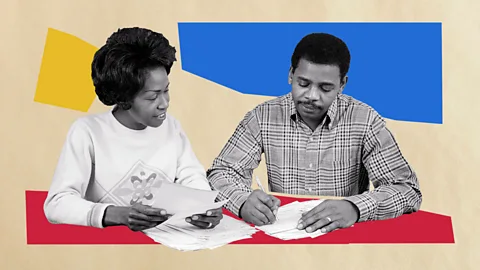 Javier Hirschfeld
Javier HirschfeldThere are psychological benefits to creative writing, too, research suggests. One study by Plymouth University and Nottingham Trent University in the UK found that writing and discussing poetry as a means to deal with the Covid-19 pandemic helped people to cope with feelings of loneliness and isolation, as well as help to reduce feelings of anxiety and depression. A similar study published in 2021 found that creative writing may encourage personal growth and a sense of inner peace.
Book clubs can also be an affordable way to socialise, especially if you borrow the book from a library. Reading may even have health benefits, such as cognitive benefits, potentially making it another hobby that provides a social as well as physical boost.
For anyone who is nervous about joining a book club, Curry offers the reminder that you always have the book in common if you're feeling shy: "A lot of the women that come are very open, very friendly and they'll do things like follow up with each other… I provide friendship tips, we have name labels and we swap [around] so that you get to chat to lots of new people."
Having a class that was structured meant that people felt braver and more open to chatting with others. It can be hard to muster up the courage to start a conversation, so knowing that everyone would get a chance to speak provided a bit of light relief.
4. A life drawing class: £15 ($18)
"I can't think of a better place to be an artist than London," says Ann Mackowski, artist and founder of Soho Life Drawing, a drawing group that runs weekly drop-in sessions in the heart of central London. Oh, and there's tea and biscuits.
Before I attended one of her relaxed life drawing workshops (also known as figure drawing), I would have told you that I am awful at sketching or drawing. Really awful.
Unfortunately, I'd say the same thing now. But my skill level didn't matter.
Drawing, especially when done in a way that makes us focus on the world around us, can improve mood and wellbeing, research suggests. As I quietly focused on sketching, it felt incredibly calming. I left the session feeling relaxed and proud that I was able to even sketch the outline of a body.
As with the other activities I tried out, I discovered that life drawing offered a surprising additional benefit beyond the promise of social connection: it can have a positive impact on body image. One study showed how it just took six weeks of classes to notice feelings of body pride and elevation. Another study showed that for women in particular, greater attendance of life drawing classes was associated with higher body appreciation, as well as and a lower drive for thinness and social physique anxiety.
The workshop consisted of sketching a naked person in different poses, accompanied by guidance from Mackowski through the first hour. After a break where we chatted amongst us (with aforementioned tea and biscuits), the session resumed with longer poses for the second hour. Mackowski created a friendly, safe and tranquil space for all, regardless of skill level. Some people were gently reintroducing themselves to life-drawing, others trying something brand new, others had been honing their skills for years.
"You get people coming in, they make friends, they come back," says Mackowski, adding that the connections people form through her classes has been one of the reasons why she's continued running them for many years. "It becomes like a little family for some people. Then they might go to other classes together and venture out."
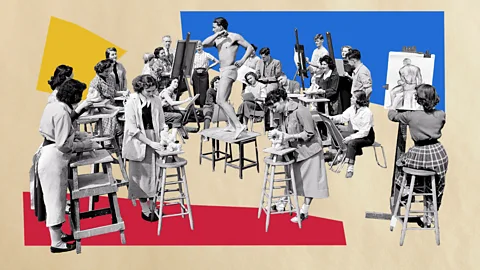 Javier Hirschfeld
Javier HirschfeldIn fact, in a 2021 survey in the UK on the arts and social connectedness, 82% of participants responded that engagement in the arts was linked with feelings of social connection, belonging and collective understanding.
Mackowski adds that having an artistic community can help people both socially and from a technical standpoint: "People develop their skills a lot quicker if they can see other people's work… and identify styles. So if you're in a room with 30 people and you can view their work, beginners get a good idea of where to go. And it's known to increase levels of creativity." At the end of our session, there was an opportunity to share your finished work with peers or Mackowski for feedback.
A successful mission?
In terms of my original quest – to find out which activity would be best for making friends – all the ones I tried were a success. Each formed a gateway to a community and new friends, while offering other benefits I hadn't even thought about when starting this mission.
Embarking on a new hobby is, of course, just a first step – it may not be an instant solution to the widespread problem of social isolation and loneliness and the search for social connection. Still, my experience alongside the research on how we as a species bond through shared activities, suggests that it's worth trying out a new activity where you might meet people with similar interests to you. In fact, at the start of this year, 19% of Americans made a New Year's resolution related to a hobby or a skill, according to a poll by the American Psychiatric Association.
If you're not sure how to break the ice, here's an opening line I used several times when talking to my fellow boulderers, writers and aspiring artists: "Have you ever done this before?" Admittedly, it may not be the world's greatest or most eloquent – but it did the job of getting us chatting. And for me at least, that awkward small talk quickly led to genuinely enjoyable conversations – and shared moments of connection.
--
If you liked this story, sign up for The Essential List newsletter – a handpicked selection of features, videos and can't-miss news, delivered to your inbox twice a week.
